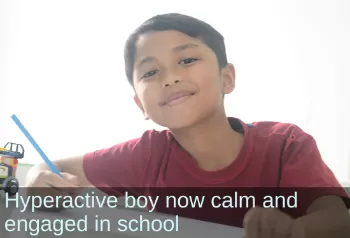Primitive Reflex Integration Case Studies
ADHD Turnaround—Huge Progress with Sleep, Academics, Social Skills, Behavior, and Handwriting
Help for ADHD, dyslexia, and CAPD challenges.
A history of ADHD, dyslexia, and CAPD resulted in a host of issues for this boy, including poor impulse control, attention challenges, difficulty following directions, social issues, and fine motor challenges. Rhythmic movements and primitive reflex integration helped improve his behavioral, learning, attention, and social challenges.
Submitted by Theresa Rafferty, COTA/L

| Before | After |
|---|---|
| Poor impulse control, difficulties at school | Special education teacher is reporting great behavior throughout the school day, and an increased ability to sit and attend to independent work (completing 30 minutes of math work independently several days during the week) |
| Handwriting challenges | Improvements in handwriting |
| Inattention/difficulty processing verbal instructions | Improvements in following instructions |
| Frequent outbursts | Participating more willingly in chores and family routine with far fewer tantrums/behavior challenges |
| Difficulty making and maintaining friendships and participating in social scenarios | Has developed a friendship with a neighbor boy and, with adult support, engages in team activity playing flag football |
Ryker is a 7-year-old boy with a history of ADHD, dyslexia, and CAPD resulting in avoidance behaviors, poor impulse control, inattention/difficulty processing verbal instructions, and behavior outburst secondary to frustration. Handwriting, visual memory, speech deficits, and reading (of course) are all challenge areas scholastically. Socially Ryker has difficulty making and maintaining friendships and participating in social scenarios. Ryker would be “on the go” from sun up to well past sun down due to the hyperactivity portion of his ADHD diagnosis.
I began working with Ryker strictly with Rhythmic Movements (RM) [from the Brain and Sensory Foundations course] as a means to increase regulation and attempt to achieve a calm body. Sessions were very brief initially, gradually building up tolerance to up to 15 min total of RM #1 - #4. Family training was completed for continuation in home environment. When checking in with mom, it was reported that when RM with Ryker were completed at bedtime, he would completely relax the tension in his body and frequently would fall asleep, staying asleep for 8-10 hours at a time!
Improvements were beginning to show in the 1st grade classroom as well, with teacher reports of increased ability to attend to classroom assignments for up to 10 minutes prior to a movement break.
RM continued to be completed over the summer break with a schedule created to complete movements first thing after he woke up and at the end of the day to calm before bed. Ryker would request the movements if for some reason the schedule was interrupted, or remind mom that she “forgot”.
Beginning 2nd grade, Ryker now participates not only in consistent RM #1 - #4, but ATNR reflex integration techniques [from the Brain and Sensory Foundations course]. One month into consistent RM and reflex integration, Ryker’s special education teacher is reporting great behavior throughout the school day, an increased ability to sit and attend to independent work (completing 30 minutes of math work independently several days during the week), and improvements in handwriting abilities!
At home, parent reports are now Ryker is demonstrating improvements in following instructions and participating more willingly in chores and family routine with far fewer tantrums/behavior challenges. He has developed a friendship with a neighbor boy and, with adult support, engages in team activity playing flag football.
The current plan is continuing to work on integrating ATNR reflex then progressing through additional reflexes to help Ryker achieve his highest potential with scholastic and interpersonal skills. We’re looking forward to seeing the progress Ryker can make in his future!
[Edited for length and clarity, emphasis added]
*Disclaimer: The activities in the Brain and Sensory Foundations curriculum make use of the natural processes of neuroplasticity and development that are innately wired in the design of human beings to promote maturity and function. These activities appear to calm, organize, and mature the neuro-sensory-motor systems just as we see in the healthy development of human infants. Individual results may vary, and we do not claim to offer a diagnosis or cure for any specific condition or disorder. The Brain and Sensory Foundations activities appear to improve overall functioning resulting in measurable improvements for a range of conditions as demonstrated in over 1800 case studies from participants.

